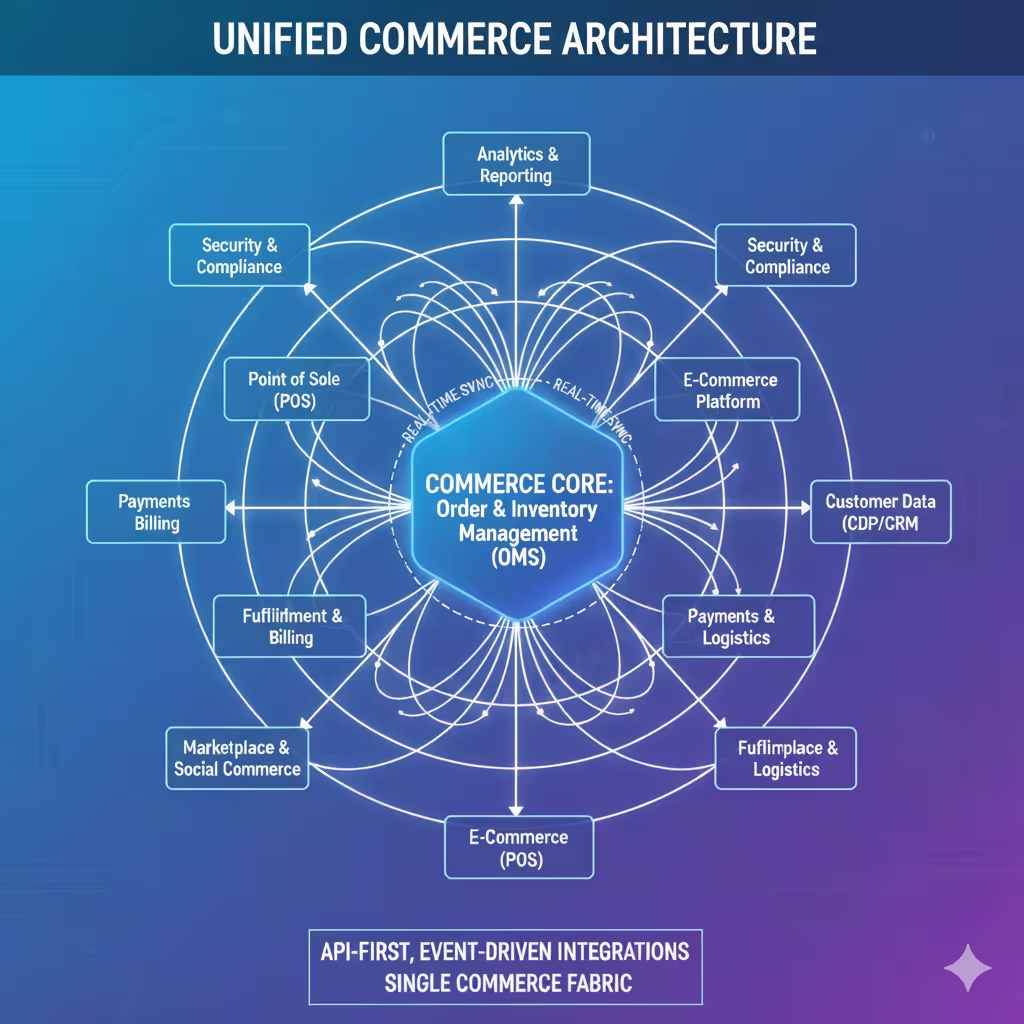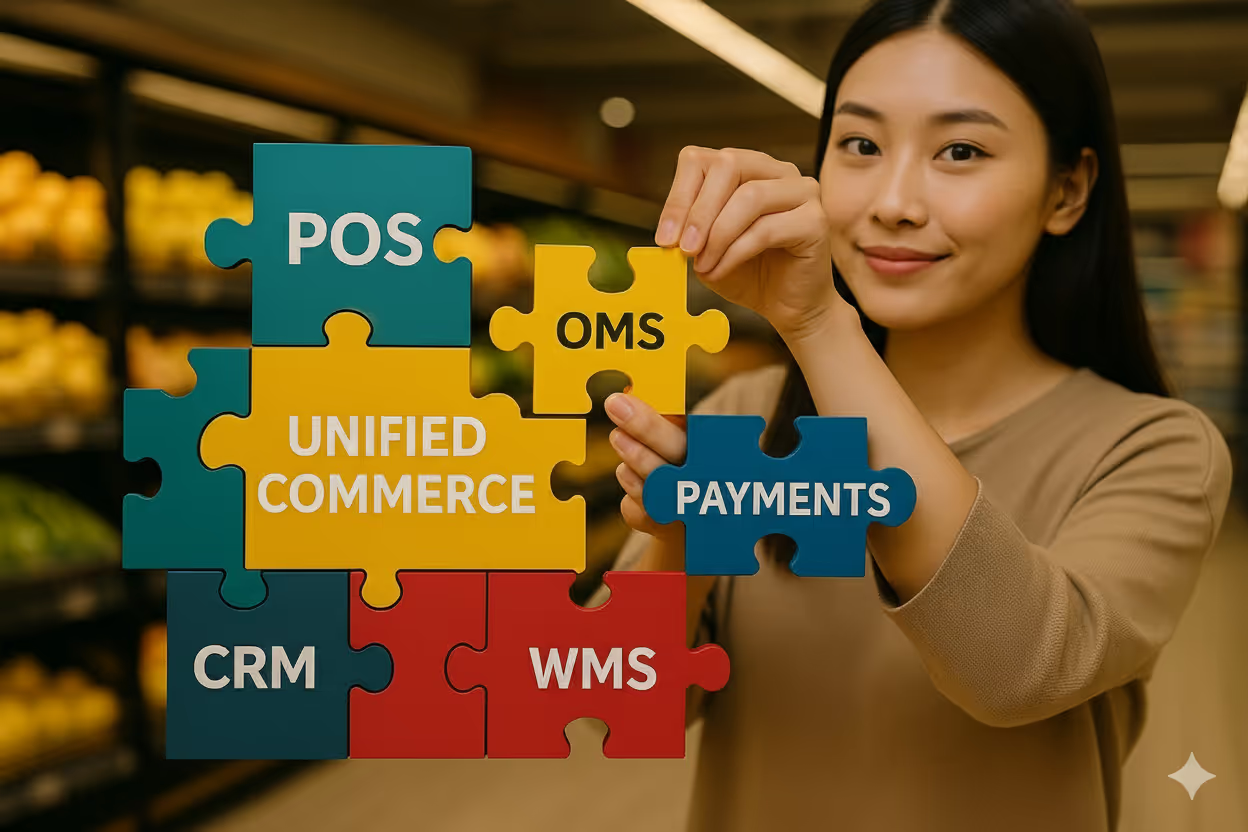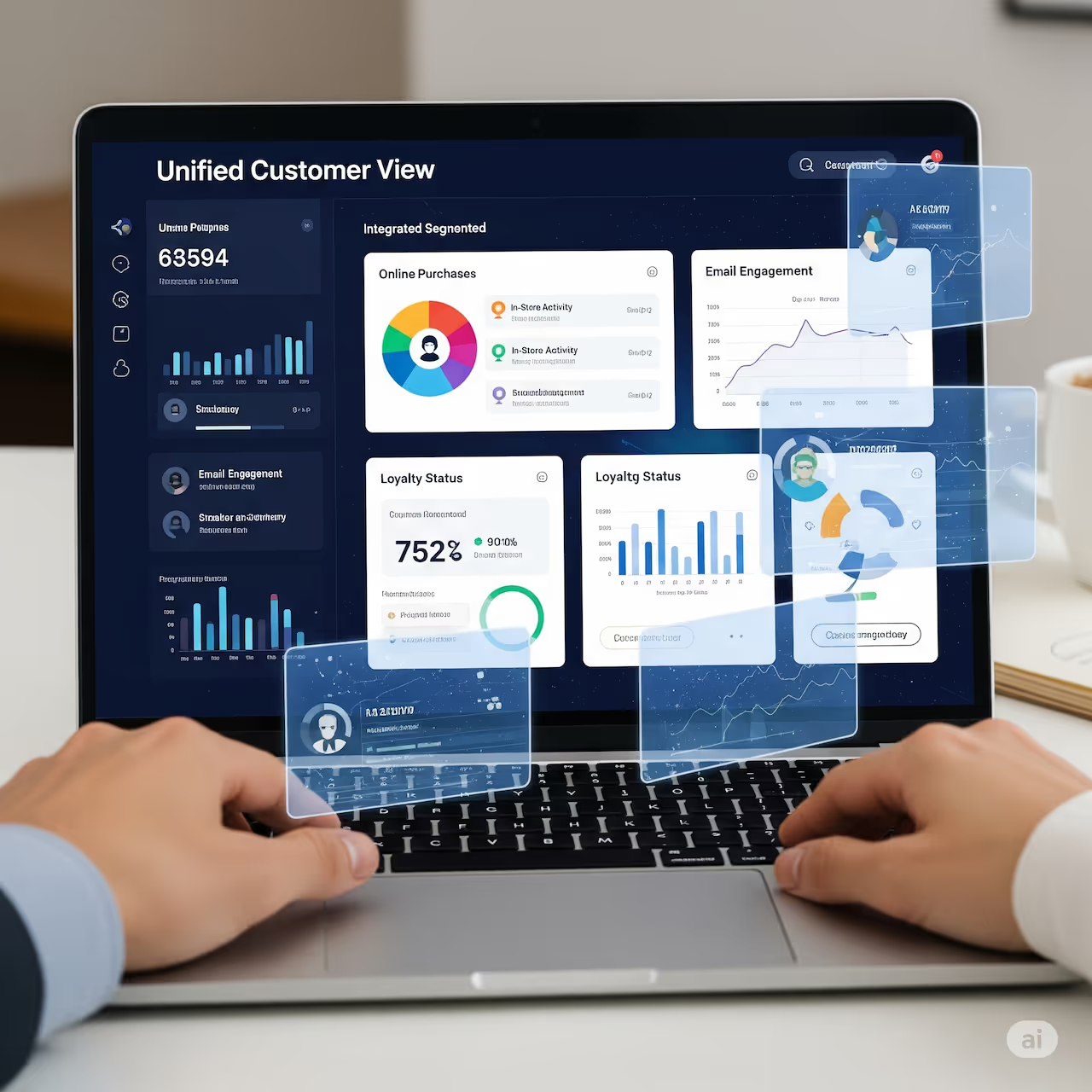It was only a few years ago that "going omnichannel" felt revolutionary. Add e-commerce to your brick-and-mortar stores, sync a few promotions between channels, and suddenly, you could call yourself digitally transformed.
Then came the headless commerce wave- decouple your backend from frontend, embrace API-first architecture, and unlock the freedom to craft unique digital experiences. However, as mid-market retailers discovered, having more tools often meant having more silos, not fewer. The promise of a seamless experience became a patchwork of workarounds, leading to more complexity.
This is where Unified Commerce entered the story as the inevitable next step - one fabric that finally connects it all !
The Great Unification: Why Now?
Unified commerce isn't about adding more technology to your stack. It's an architecture- a framework which creates a single commerce fabric that stitches together every capability- eCommerce, POS, order management, inventory, payments, and customer data into one centralized architecture with a unified source of truth.
It's what allows a shopper to check stock availability online, redeem loyalty points in-store, and return products via courier- all without your operations team scrambling to reconcile spreadsheets behind the scenes.
Who should care? Mid-sized retailers expanding from 5 to 50 stores, scaling SKUs into the thousands, or juggling multiple channels across owned sites, marketplaces, and social commerce. If your team spends more time firefighting "out of stock" errors than growing the business, this evolution is for you.
The Hidden Bleeding Points in Retail Operations
The biggest operational leaks in retail aren't always visible on dashboards. They surface as stockouts when your warehouse is full because POS data lags behind actual inventory. They emerge as customer frustration when a buy-one-get-one promotion works online but gets rejected at checkout in-store. They compound through manual reconciliations that delay refunds and create friction for finance teams. They multiply when your CRM has no visibility into loyalty redemptions happening at the till, creating fragmented customer views that undermine personalization efforts.
You recognize the pattern. Each disconnected channel adds to your “operational debt,” compounding inefficiencies over time. Unified commerce eliminates this by creating one continuous flow across all systems:
- Operational impact: Inventory accuracy rises to 98%+, fulfillment errors drop, and returns become painless.
- Financial impact: Clean reconciliation reduces leakage and protects margins.
- Customer impact: Shoppers enjoy consistent pricing, seamless loyalty usage, and unified service across every channel.
- Strategic impact: Builds the backbone for AI-driven personalization, loyalty expansion, and regional scaling.
Think of unified commerce not as “one big platform,” but as the digital nervous system that keeps every part of your retail operation in sync.
The Readiness Signals: When to Make the Jump
You don’t need unified commerce on day one. But clear signals tell you when your fragmented setup has reached its limits.
Growth triggers that demand unification:
- Expanding from a single channel (store-only or eCom-only) to true multi-channel operations.
- Managing 1,000+ SKUs or juggling complex fulfillment models like BOPIS and same/next-day delivery.
- Scaling from 5 to 20+ physical locations.
Complexity flags that signal strain:
- Customers complaining about “out of stock” online or in-store when warehouses are full.
- Rising return rates from inconsistent product data across channels.
- Loyalty programs or promotions that only work in one channel.
Regional reality check: In APAC, many retailers are leapfrogging legacy ERP and POS systems altogether, moving straight to SaaS-native unified commerce platforms. That’s why Shopify Plus and VTEX now power not just D2C upstarts but established regional chains.
The question isn’t if this shift will happen- it’s whether your business will lead it or lag behind competitors.
Anatomy of a Unified Commerce Stack
Unified commerce isn’t a single product you buy. It’s a connected framework built around real-time inventory as the control center. This “commerce core” synchronizes every channel, system, and workflow, ensuring one version of the truth for customers and teams alike. From there, the stack extends outward through integrated layers that span POS, eCommerce, payments, customer data, fulfillment, marketplaces, analytics, and compliance.
Core building blocks of a unified commerce architecture:
- Order & Inventory Management (OMS): The central orchestrator managing fulfillment across every channel simultaneously.
- Point of Sale (POS): Cloud-native, mobile-first, and integrated tightly with OMS and customer data.
- E-Commerce Platform: A unified product catalog with consistent pricing and synchronized promotions across digital touchpoints.
- Payments & Billing: End-to-end handling of transactions, subscriptions, refunds, and financial reconciliation.
- Customer Data Platform (CDP/CRM): Unified profiles combining loyalty, purchase history, and personalization signals.
- Fulfillment & Logistics: Warehouse operations, carrier integrations, and seamless returns management.
- Marketplace & Social Commerce: Native links to Amazon, Flipkart, TikTok Shop, and new regional platforms.
- Analytics & Reporting: A single dashboard providing insights across operations, marketing, and finance.
- Security & Compliance: Enterprise-grade controls covering PCI-DSS, GDPR/PDPA, and role-based access.

How it works in practice:
The commerce engine synchronizes orders, payments, and inventory in real time. OMS bridges online and in-store availability so shoppers see accurate stock. Unified profiles merge purchases, returns, and loyalty into a 360° customer view. A single payment gateway simplifies checkout and reconciliation, while unified analytics puts everything on one dashboard. And because it’s built on API-first, event-driven integrations, every system stays updated instantly.
Done right, this isn’t a patchwork of tools. It’s a commerce fabric—a unified backbone - a single source of truth, serving every stakeholder: customers, associates, operations, finance, and partners.
The Vendor Evaluation Framework: Cutting Through the Marketing Noise
If you’re a D2C brand or mid-market retailer, a unified commerce suite is often the smartest starting point. Platforms like Shopify Plus, BigCommerce, VTEX, Adobe Commerce, Salesforce Commerce Cloud, and Unicommerce bundle eCommerce, POS, OMS, payments, and customer data into one system-helping you scale quickly without heavy integration overhead.
For larger or more complex retailers, the better path is usually hybrid or composable- stitching together best-of-breed tools like Commercetools (commerce core with basic OMS), Fluent Commerce or Manhattan Active (advanced OMS), Adyen or Stripe (payments), Algonomy or Dynamic Yield (personalization), Blue Yonder or Relex (fulfillment and demand forecasting), and Segment or Zeotap (customer data). The payoff is flexibility and depth, supporting advanced fulfillment models, multi-region operations, and thousands of SKUs.
Regardless of size, the real challenge is separating genuine capability from marketing gloss. Here’s a systematic evaluation framework to guide that decision:
Evaluation Dimension | What Good Looks Like | Red Flags
- Core Must-Haves | Real-time inventory sync across channels; POS, OMS, eCom, and payments work seamlessly; modular and API-friendly. | Lookout for - “Bolted-on” modules; reliance on manual uploads/Excel; sync delays.
- Integration Needs | Plug-and-play connectors for ERP, WMS, CRM, loyalty, and payments; smooth APIs for third-party tools. | Lookout for - Expensive middleware just to connect basics; poor support for local wallets or ERPs.
- Pricing & TCO | Transparent pricing (per store, per order, or monthly); low setup fees; scales fairly. | Lookout for - Hidden charges (API calls, “premium” support); high training fees; long lock-ins.
- SaaS Maturity & Compliance | 99.9% uptime SLA; PCI and GDPR/PDPA certified; clear roadmap for AI/automation; strong rollout and support. | Lookout for- Weak uptime guarantees (<99.5%); vague compliance; no local hosting.
- Staff Adoption | Intuitive UI; one login; mobile/tablet-friendly; offline mode support. | Lookout for- Steep training curve; multiple logins; tied to proprietary hardware; no offline fallback.
- Legacy Migration & Rollout | Vendor assists with data migration; phased rollout (e.g., pilot in 2–3 stores first); clear 30-day test plan. | Lookout for- “Big bang” rollout only; no migration tools; high downtime risk.
Key Questions for Vendor Evaluation
Before signing on with any unified commerce vendor, demand clear answers to operational questions that reveal whether the platform works in practice:
- How do you guarantee real-time stock synchronization across POS, e-commerce, and marketplace channels?
- Which system integrations come prebuilt versus requiring custom development?
- What does your phased rollout process look like for multi-location retailers?
- What’s your data portability policy if we need to migrate away?
- Can you demonstrate your mobile interface for store associates in a live environment?
- How does your system handle offline operations during connectivity outages?
- What’s the process for managing online returns through physical stores?
- What specific AI and analytics features are on your 12-month roadmap?
These questions cut through the glossy demo and expose whether a vendor is truly ready for retail at scale.
The Implementation Reality: What Actually Happens
Even the best vendor pitches gloss over the hard part—execution. Here’s what to expect in practice:
- Timeline expectations: Plan for 3-6 months of implementation, not the "instant deployment" promised in sales presentations.
- Staff training requirements: Store associates need hands-on support to transition from the legacy systems they've used for years.
- Change management critical success factor: Adoption success depends entirely on getting frontline teams to trust and embrace the new unified source of truth.
Unified commerce is as much a cultural shift as it is a technical upgrade.
Measuring Success and ROI
How do you know if unification is paying off? Look for early operational wins and longer-term financial impact:
- Operational: 98%+ inventory accuracy, faster fulfillment cycles, and smoother returns.
- Financial: Reduced revenue leakage from reconciliation errors; stronger margin control.
- Customer: Fewer “out of stock” complaints, better repeat purchase rates, and higher lifetime value.
- ROI timeline: Expect visible improvements within the first quarter, with full payback in 12–18 months.
Agentic Commerce- The Road Ahead.
Commerce has always evolved in waves. E-commerce digitized storefronts. Omnichannel blurred the line between physical and digital. Headless architectures freed the frontend. Unified commerce is now delivering operational coherence.
The next chapter? Agentic commerce, where AI agents don’t just assist shoppers- they act on their behalf. Agents can find products, compare options across multiple channels, apply the best discount combinations, and complete transactions end-to-end.
For retailers, this means your systems must be optimized not only for human shoppers but also for machine-readable interactions. Clean APIs, real-time data, and unified architectures become non-negotiable.
Unified commerce is the essential foundation for this future. Without it, autonomous agents won’t be able to discover your inventory, validate prices, or complete seamless transactions on behalf of customers.
The takeaway is clear: the agentic era isn’t decades away - it’s already emerging. The question is whether your unified commerce foundation will be ready to power it or risk being invisible in an AI-driven marketplace.


.avif)


.avif)